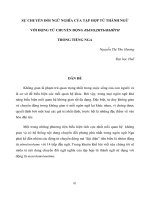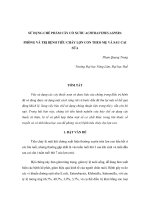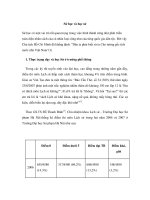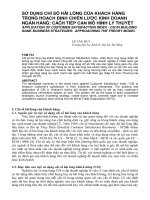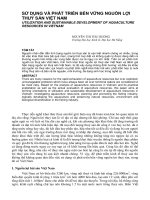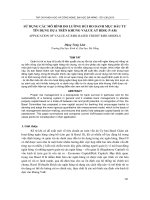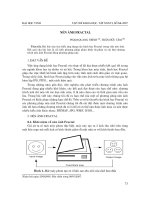Báo cáo nghiên cứu khoa học: "Sự ảnh hưởng của áp lực giáo dục về sức khỏe tâm thần của thanh thiếu niên ở Đông Nam Á: Các phương pháp và công cụ để nghiên cứu" pot
Bạn đang xem bản rút gọn của tài liệu. Xem và tải ngay bản đầy đủ của tài liệu tại đây (129.18 KB, 14 trang )
109
JOURNAL OF SCIENCE, Hue University, N
0
61, 2010
THE INFLUENCE OF EDUCATIONAL PRESSURE ON THE MENTAL
HEALTH OF ADOLESCENTS IN EAST ASIA:
METHODS AND TOOLS FOR RESEARCH
Michael P. Dunne
1
, Jiandong Sun
1
, Nguyen Do Nguyen
2
,
Thai Thanh Truc
1,2
, Kim Xuan Loan
1,2
, Jason Dixon
1
1
School of Public Health,
Queensland University of Technology (QUT)
2
Faculty of Public Health, Ho Chi Minh City University of Medicine and Pharmacy
SUMMARY
Pressure to succeed in school education is intense in East Asian countries, and appears
to be increasing as society becomes more competitive. Although competitive stress can be a
positive stimulus for achievement for young people, if this stress is severe and prolonged it can
have a major impact on health and well-being. The negative effects include depression, anxiety,
behavioural problems and youth suicide. Although the impact of educational pressure on young
people and families is discussed widely in the media and society, much of this is based on case
studies and anecdotes, rather than systematic research. This paper describes the rationale,
research design and procedures and the development and initial validation of a new instrument
to measure academic stress among young people in Asia. A recent survey of 2000 adolescents in
Shandong province, China, is described and technical details of a new research tool - the
Educational Stress Scale for Adolescents (ESSA) are provided. A proposal for a study in north,
central and southern Vietnam is then discussed. Hopefully, this work will contribute solid
evidence to inform public debate and practical action to address this substantial mental health
problem.
1. Introduction
Academic learning is among the most important sources of stress faced by
young people worldwide. Asian students in particular often have high academic burden,
low satisfaction regarding their academic performance and strong external pressure to
study, and may suffer more academic stress than their counterparts in English speaking
countries.
Throughout East Asia there is growing recognition of academic burden and the
impact on health and well-being of students. Sometimes the issue becomes highly
prominent in the media in response to tragic events such as youth suicide around exam
times. There is also attention being paid at the national and regional government levels
110
that lead to a large-scale analysis of these problems. For example, a Chinese national
survey conducted with 5040 adolescents and 6552 parents by the All-China Women’s
Federation (2008) reported that nearly half (49.1%) of the students in secondary schools
spend at least 2 hours per day for homework assigned by their teachers. Another
national survey found that most children and adolescents (66.7%) considered academic
pressure as the biggest stress in their lives. Pressure from transitional examinations and
study workload are associated with poor mental health among Chinese adolescents.
High academic pressure may also lead to physical violence and developmental problems.
An early study in Vietnam revealed that more than 50% of adolescents
experience personal pressure to achieve good grades, have high expectations from
parents, and worry about securing employment after graduation. Fear of failure to meet
family expectations and the burden of preparations for tests cause significant stress.
Recently, the second national Survey Assessment of Vietnamese Youth (SAVY-2)
conducted in 2009 found that pressure from parents regarding academic achievement
and study habits was quite common, and adolescents who reported academic pressure
were between 40% to 60% more likely than other young people to have strong feelings
of sadness.
Although these recent studies stimulate discussion of the problem, to date most
research in East Asia countries has not examined the complex phenomenon of
educational stress in much detail. The existing surveys have included only a few
indicative questions. There is a need for in-depth research into the multidimensional
nature of academic stress and pressure, and this should include study of relationship
with mental health. To do this well, it is necessary to ensure that research projects are
systematic and utilise culturally appropriate research instruments. Here, we describe the
development and testing of a new research tool and describe the procedures we have
and will apply in school-based research in China and Vietnam.
2. Measurement of Academic Stress
A number of self-report instruments have been developed to assess academic
stress among youth. These include the Academic Stress Questionnaire (ASQ, Abouserie,
1994), Student Stress Inventory (SSI, Zeidner, 1992), Academic Stress Scale (ASS,
Kohn & Frazer, 1986), Lakaev Academic Stress Response Scale (LASRS, Lakaev,
2009), Student-life Stress Inventory (SSI, Gadzella, 2001), High School Stressor Scale
(HSSS, Burnett & Fanshawe, 1997), Academic Expectation Stress Inventory (AESI-9,
Ang & Huan, 2006a), and Survey of Academic Stress (SAS, Bjorkman, 2007). Most of
these scales were designed to measure academic stress among college or university
students and only three have been used in surveys with secondary school students. All
but the AESI-9 (Ang & Huan, 2006a, 2006b) were developed and validated in western
countries.
111
The AESI-9 was developed with Singapore students to measure the level of
stress arising from academic expectations of both the students and significant others. Its
psychometric profile has been well established and cross-cultural validity has also been
tested with both Chinese and Hispanic students (Ang & Huan, 2006a, 2006b).
Nevertheless, one limitation of this scale is its exclusive focus on academic expectations
and it does not capture other dimensions of academic stress.
Based on extensive review of both English and Chinese literature, no instrument
has been developed and validated with secondary school students in East Asia. This
could partly explain the relative paucity of research into academic stress in this region.
In this paper, we summarise work recently completed in Shandong, China to develop a
multidimensional tool, including the assessment of reliability and validity. The paper
concludes with an outline of a plan to study links between academic stress and mental
health in Vietnam in schools in 2010.
PART A: Research in schools in Shandong, China
Methods
This study included three cross-sectional questionnaire surveys with
convenience samples of students (grades 7-12) from six secondary schools in three sites
(the capital city, one county city and one rural town) in Shandong Province. These
surveys were conducted in September and October 2009. The objective of the first
survey was to explore the factor structure, internal consistency, concurrent validity and
predictive validity of the draft Educational Stress Scale for Adolescents (ESSA). The
second survey was to assess the test-retest reliability. The third survey was to evaluate
the robustness of the factor structure established in the first survey.
Participants
Scale development sample. The first sample contained 364 grade 8 and 11
students. Data analysis was conducted with 347 students with a response rate of 95.3%.
Of them, 44.8% were female and all were from the Han Chinese ethnic group. The age
of the sample ranged from 12 to 18 (Mean=15.37, SD=1.69). Students from urban and
rural families accounted for 43.2% and 56.8% of the sample, respectively.
Test-retest reliability sample. Two weeks later, a subset of the first sample (two
classes, N=148) participated in a second survey with the same questionnaires. Data
analysis on test-retest reliability was done with 135 (91.2%) respondents. The
demographic characters were similar to the first sample.
Main survey sample. A total of 1740 eligible participants (grades 7 through 12)
from 36 classes were invited to participate in the third survey. Complete data were
obtained from 1670 (95.8%) students and were included into analysis. Of them, 44.6%
were female and almost all (99.3%, 1659/1670) were ethnically Han Chinese. The age
112
of the respondents ranged from 11 to 20 (Mean=15.44, SD=1.85). Urban and rural
students accounted for 42.2% and 57.8% of the sample, respectively.
Measures
Educational stress. The first draft of the ESSA was constructed with 30 items
based on review of the literature to capture multiple dimensions of stress related to
academic activities. Seven items were adapted from the AESI (Ang & Huan, 2006a).
Participants were asked to rate each statements on a 5-point Likert scale ranging from 1
(Strongly disagree) to 5 (Strongly agree) with higher scores indicating greater stress.
The initial scale was used in the first two surveys. The refined version containing 16
items was used in the third survey.
Academic expectation stress. The translated AESI-9 was used. This 9-item
scale has two subscales, Expectations of Parents/Teachers (five items) and Expectations
of Self (four items). Respondents rated each statement on a 5-point Likert scale ranging
from 1 (never true) to 5 (almost always true). It has good internal consistency
(Cronbach’s α = .89 for the total scale, .84 85 for two factors) in the study by Ang &
Huan (2006a). In the present study, the translated AESI-9 also showed good internal
reliability in both the first (Cronbach’s α = .85, N=340) and the third survey (Cronbach’s
α = .86, N=1642).
Depressive symptoms. The Chinese version of Centre for Epidemiological
Studies – Depression Scale (CCES-D, Radloff, 1977; Liu, 1999) is a 20-item self-report
instrument for depressive symptoms. It was found to have good internal reliability in
both the first (Cronbach’s α = .87, N=325) and third sample (Cronbach’s α = .88,
N=1598) in this study.
Suicidal thoughts. Suicidal thoughts were measured using one question “In the
past 12 months, have you ever seriously considered attempting suicide?”, adopted from
the youth risk behaviour survey (YRBS) questionnaire (Eaton et al., 2008).
Academic grades. Participants were asked to rank their average grades during
the past 12 months into one of the five categories: Very poor, Poor, Middle, Good, and
Very good. In data analysis, the first two and last two groups were combined as Very
poor/Poor and Good / Very good, respectively, resulting in three categories of
achievement.
Procedure
All surveys were conducted in schools during self-study sessions. A brief
introduction was given by the investigator (Jiandong Sun) and followed by the
distribution of consent forms and information sheets. The survey questionnaire was
then administered to the students who signed consent forms. On average, it took 30
minutes for the students to complete the questionnaire. For the test-retest survey, a
113
technique reported by Brener and colleagues (1995; 2002) was followed to assure
anonymity and obtain matching data from participants.
Ethics Approval
Participation was entirely voluntary and anonymous. This project obtained ethics
approval from the QUT Human Research Ethics Committee and the Preventive
Medicine Ethics Committee of Shandong CDC. Before the data collection, written
approval was given by the principal/vice principal of each participating school and
consent was gained from each student.
Results: Shandong Study
Exploratory Factor Analysis (EFA) yielded seven factors that cumulatively
accounted for 59.4% of the total variance. However, six items had a poor loading (<.5)
on all factors and eight had crossed loadings (loading ≥.5 in one factor but ≥.4 in one or
more of other factors). These items were removed from further analyses. Another EFA
was then conducted for the revised 16-item ESSA scale with the same data. Five factors
were identified and labelled as Pressure from study, Worry about grades, Despondency,
Self-expectation, and Workload (see Table 1). These latent variables explained 26.6%,
14.4%, 8.2%, 7.6%, and 6.7% of variance respectively, and together 63.6% of the total
variance. There are 3 or 4 items in each factor (see Table 1).
Reliability
Inter-item consistency: Based on the data from the first survey (N = 347), the
Cronbach's alpha for the total 16-item ESSA scale was .81 indicating good internal
consistency. The coefficients were .74, .71, .66, .66, and .75 for the five factors
respectively, all suggesting acceptable to good levels of reliability/
. Test-retest reliability: Using the data from the second sample (N = 135), the
ICC for the total ESSA score was .78, and for the five factors was .75, .61, .70, .59,
and .62, respectively, all suggesting good test-retest reliability. The ICC for each of the
16 items varied from .44 to .67 suggesting moderate to good reliability over two weeks.
Concurrent and Predictive Validity
In the first sample (N = 347), the total score and three factors of the ESSA were
significantly correlated with AESI scores (Table 2). The overall ESSA score was
negatively correlated with academic grades (Spearman r = 20, p < .001), indicating
that students with low academic achievements have more stress. However, only two of
the five factors (Despondency and Workload) showed significant correlations with self-
reported academic grades (Table 2).
If the ESSA is to be useful for research it should be found that the scores
correlate significantly with youth mental health problems. In this study, the total
114
academic stress score and all factors were positively correlated with Depression scores
(Table 2). Among students who had considered committing suicide (N=68), the mean
ESSA score (M = 57.24, SD = 9.15) was significantly higher than the score among those
who had not (N = 266, M = 53.35, SD = 9.21), t(332) = 3.11, p = .002, d = 0.42. This
association showed small to medium effect size.
Table 1. Factor Pattern and Structure Coefficients, Communalities, and Means (SDs) for the
ESSA in the First Survey (N=347)
Factor and item PC SC h
2
Mean (SD)
Factor 1: Pressure from study 13.99 (3.56)
There is too much competition among classmates
which brings me a lot of academic pressure.
.80 .79 .67 3.53 (1.09)
I feel a lot of pressure in my daily studying. .79 .81 .66 3.35 (1.08)
Future education and employment bring me a lot
of academic pressure.
.74 .78 .63 3.83 (1.18)
My parents care about my academic grades too
much which brings me a lot of pressure.
.56 .65 .48 3.28 (1.25)
Factor 2: Worry about grades 11.38 (2.7)
I feel that I have disappointed my teacher when
my test/exam results are not ideal.
.93 .87 .80 3.63 (1.07)
I feel that I have disappointed my parents when
my test/exam results are poor.
.72 .80 .69 4.17 (.96)
Academic grade is very important to my future
and even can determine my whole life.
.64 .71 .58 3.6 (1.33)
Factor 3: Despondency 9.31 (2.83)
I am very dissatisfied with my academic grades. .82 .79 .65 3.48 (1.20)
I always lack confidence with my academic
scores.
.73 .78 .62 2.67 (1.24)
It is very difficult for me to concentrate during
classes.
.58 .67 .53 3.17 (1.23)
Factor 4: Self expectation 9.91 (2.56)
I feel stressed when I do not live up to my own
standards.
.82 .82 .70 3.44 (1.12)
115
When I fail to live up to my own expectations, I
feel I am not good enough.
.79 .78 .62 3.71 (1.02)
I usually cannot sleep and worry when I cannot
meet the goals I set for myself.
.66 .70 .51 2.76 (1.17)
Factor 5: Workload 9.51 (2.90)
I feel there is too much homework. .81 .84 .73 3.3 (1.20)
I feel that there is too much school work. .81 .81 .69 3.01 (1.16)
I feel that there are too many tests /exams in the
school.
.77 .77 .61 3.21 (1.20)
ESSA .80 .79 .67 54.14 (9.32)
Note. ESSA = Educational Stress Scale for Adolescents; PC = Pattern
coefficient; SC = Structure coefficient; h
2
= communalities; SD = Standard deviation
Table 2. Correlations between Scores from ESSA, AESI, CES-D and Academic Grades in the
First Survey (N=347)
1 2 3 4 5 6 7 8 9 10 11
1. ESSA total 1
2. Pressure from
study
.81
**
1
**
3. Worry about
grades
.57
**
.34
**
1
4. Despondency .67
**
.44
**
.14
**
1
5. Self-
expectation
.55
**
.27
**
.35
**
.19
**
1
6. Workload .58
**
.39
**
.05 .33
**
.04 1
7. AESI total .51
**
.29
**
.52
**
.07 .83
**
03
1
8. AESI-Other
expectations
.41
**
.26
**
.53
**
.01 .58
**
06
.92
**
1
9. AESI-
Self
expectations
.52
**
.26
**
.39
**
.13
*
.96
**
01
.88
**
.62
**
1
10. CES-D
(Depression)
.47
**
.38
**
.15
**
.44
**
.24
**
.25
**
.19
**
.13
*
.22
*
*
1
11. Academic
grades
a
20
**
.10 .03
-
.43
**
.02 13
*
.16
**
.21
**
.07
-
.17
**
1
116
Note. ESSA = Academic Stress Scale for Adolescents; AESI = Academic
Expectation Stress Inventory; CES-D = Centre for Epidemiological Studies –
Depression Scale
a
Spearman r (others are Pearson r)
*
p<.05;
**
p<.01
Confirmatory Factor Analysis (CFA)
A CFA was conducted using the data from the third sample (N = 1670).
According to the results of the traditional chi-square fit index (χ
2
(94, N = 1670) =
604.59, p < .001), the observed model was significantly different from the expected
model. However, this may be related to the large sample size. All other indices,
including the CFI (.93), NFI (.92), IFI (.93), GFI (.96), RMSEA (.06) and standardised
RMR (.05) suggested a good fit to the original factor structure.
Discussion: Shandong study
This new instrument for measuring academic stress contains can be used to
measure the multidimensional nature of educational stress, including Pressure from
study, Worry about grades, Despondency, Self-expectation, and Workload. This scale
exhibits good psychometric properties in terms of internal and test-retest reliability and
concurrent and predictive validity.
Academic stress is recognised as a risk factor for depression and suicidal
behaviour (Ang & Huan, 2006b; Bjorkman 2007). In this study, the ESSA scores show
significant associations with these problems. Compared to the AESI, the ESSA score is
more predictive of depression and suicidality (Table 2). This is probably because the
ESSA captures more elements of academic stress than the AESI. For the purpose to
identify students at risk in mental disorders, the ESSA may serve as a useful tool.
This study has some limitations. First, information was collected solely relying
upon self-report of students and hence some recall bias cannot be avoided. Second,
despite the identification of five factors, the ESSA might not capture all facets of
academic stress. In addition, the ESSA was only tested with Chinese adolescents in
Shandong and cross-cultural suitability is yet to be established. Nevertheless, this newly
developed scale demonstrates good psychometric properties and is suitable to be used in
further research into academic-related stress among secondary school adolescents. The
ESSA promises to be a useful tool with East Asian populations and possibly in other
social and cultural contexts.
117
PART B:
A proposed study of Educational Stress and Mental Health in Viet Nam.
As mentioned in the introduction, there has been little research published from
Vietnam regarding academic stress and youth mental health. This research group is
proposing to do school-based surveys in several locations in different regions in
Vietnam, including the south, centre and north. It is planned to commence the research
in Ho Chi Minh City in 2010, coordinated by the Epidemiology and Biostatistics
Departments of the Faculty of Public Health, HCMC University of Medicine and
Pharmacy. In the remainder of this paper we outline the main questions, survey design
and measures and details of the research. We invite comments and suggestions from
participants in this conference.
Research questions
1. What is the prevalence of educational stress among Vietnamese students in
secondary school and high school in Ho Chi Minh City?
2. What is the prevalence of mental health problems including depression,
anxiety, psychological distress and well-being among Vietnamese students in
secondary school and high school in Ho Chi Minh City?
3. What are the major risk factors associated with educational stress and mental
health among these students?
4. To what extent does educational stress influence depression and anxiety,
while statistically controlling the influence of other aspects of childhood
adversity and family functioning?
Sampling
A multi-stage cluster sample of secondary and high school students (aged 14-18
years) in 6 schools in HCMC will be invited to participate. This will involve in-class
surveys of about 40 students per class. With an expected response rate of 95% then
thirty classes will be needed to achieve the target sample size of n=1200. Six schools in
Ho Chi Minh City (HCMC) including 3 secondary schools and 3 high schools will be
randomly selected from a list of schools available from the Department of Education in
one district of HCMC. In each school, two classes per grade including grade 8 and 9 in
secondary schools and grade 10 to 12 in high schools will be selected.
118
Table 3. Sampling method to be used in Ho Chi Minh City
a
At each school
b
Total in each
school
Total in 3
schools
Select 3
schools
High school
2 classes -grade 10
6 classes
6 x 3 = 18
classes
2 classes -grade 11
2 classes -grade 12
Select 3
schools
Secondary
school
2 classes -grade 8
4 classes
4 x 3 = 12
classes
2 classes -grade 9
TOTAL 30 classes
a
randomly selected from a list of school (18 schools);
b
randomly selected from
a list of class in each school
Measures
Educational stress: Educational Stress Scale for Adolescent (ESSA) developed
by Sun, Dunne, Hou and Xu (2010) is comprised of 16 questions (n=16) using 5-point
scale from 1 (strongly disagree) to 5 (strongly agree) with higher scores indicating
greater stress.
Depression: The Centre for Epidemiological studies-Depression Scale (CES-D,
Radloff, 1997) has been validated in Vietnamese language, including in studies with
adolescents
Anxiety: the scale consists of 13 items (n=13) using 3-point scale (never,
sometimes, often). The scale has a high level of internal consistency and good face and
concurrent validity.
Psychological distress: The Kessler Psychological Distress Scale (K-10) is
comprised of 10 items (n=10) using a 5-point scale from none of the time to all of the
time (Kessler et al., 2003). The internal consistency coefficient of the original scale was
α=0.93. Concurrent and criterion validity has been established for this scale
Wellbeing: The World Health Organization (WHO)-Five Well-being Index
(WHO-5) is a short 5-item, positively worded instrument used to assess the level of
emotional well-being over the last two weeks. The WHO-5 uses a 6-point scale from 0
(at no time) to 5 (all of the time), the higher score represents better overall well-being.
Internal consistency of the WHO-5 is excellent (α=0.91), and criterion validity against
the Structural Interview for the Diagnostic and Statistical Manual of Mental Disorders
has been established
119
Health risk behaviour measure: Health risk behaviour items were adapted from
the Questionnaire of Youth Risk Behaviour Survey (YRBS) developed by the Centre for
Disease Control and Prevention in the USA. This scale was validated and has a high
level of reliability. The YRBS has been used in various studies among adolescents in
Asian countries such as China and Vietnam
Parental bonding: The Parental Bonding Instrument was developed by Parker,
Tupling and Brown (1979) to measure the perception of parenting to the age of 16 years.
The short-form instrument will be used to assess attitudes and behaviours of
participant’s parents. The PBI has been shown to have high level of reliability and
validity
School connectedness scale: this scale includes nine items using 5-point scale
from 1 (strongly disagree) to 5 (strongly agree); the higher score, the more school
connectedness. This scale was adapted from the National Longitudinal Study on
Adolescent Health by Resnick and colleagues (1997).(Resnick, et al., 1997)
Adverse Childhood Experience: 30 standardized items from the Adverse
Childhood Experiences (ACE) Study by the World Health Organization and the US
Centers for Disease Control and Prevention screen for childhood protection, neglect,
household dysfunction, physical abuse and exposure to community violence. The
psychometric properties of the ACE scale have been well documented
Data collection procedure
Step 1: Preparation
Authority obtained from the Scientific and Training Committee of
University of Medicine Pharmacy, Ho Chi Minh city, Vietnam
Ethics approval from QUT and HCMC University of Medicine and
Pharmacy
Pilot study with 50 students
Prepare lists of classes in 6 schools for the main survey
Prepare the timetables, classroom settings, and monitors for each class
Step 2: Participant selection
1. Students in selected classes in 6 schools
2. All students are invited to participate with informed consent
Step 3: Questionnaire distribution
All selected students are invited to answer questionnaire in the classroom
setting
The average time for answering the questionnaire is between 30-45
minutes
1
20
Completed questionnaires are to be placed and sealed in un-marked
envelop then put in a box by students
With prior agreement of the School, class teachers and assistant teachers or any
school personnel are not to be in the room while the survey is underway and they will
have no contact with the questionnaires
Ethical issues
The research will be conducted under approval of Human Research Ethics
Committees of Queensland University of Technology (QUT) and Ho Chi Minh City
University of Medicine and Pharmacy. Approval will also be granted by principals of
secondary schools and high schools in Ho Chi Minh City Viet Nam. Informed, signed
consent will be obtained from students. Parents will be advised of the survey by the
School administration and given the opportunity to withdraw their students should they
wish to do so.
The purpose of the study will be explained to pupils that participation is
voluntary. They will be advised that they are free to withdraw at any time during the
study without any comment or penalty. Participants will be informed that their
responses will remain completely anonymous and that there is no way will any
information or data be collected that will make them identifiable. The names of
participants are not required in any of the responses. In order to protect confidentiality,
questionnaires will be administered by researchers and research assistants. Teachers as
well as assistant teachers or staff will be asked to be absent during data collection. Any
research published as a result of the study will not report any information that would
make a participant identifiable. Participants will be informed that free and confidential
professional counselling will be offered to those who wish to seek these professional
services to discuss any feelings or personal issues that might arise from participation in
this survey.
3. Conclusion
We hope that these studies may contribute to better understanding and awareness
of educational stress and mental health among students in secondary schools and high
schools in China and Vietnam. This may help to fill gaps in the literature regarding the
associations between family and school pressures, risk behaviours and mental health
among Asian young people. This information should be used to stimulate further efforts
to develop and deliver effective mental health promotion programs for schools and
families. This work should include increased attention to provision of professional
counselling support for students who are troubled by the serious effects of educational
stress.
121
REFERENCES
1. Abouserie, R Sources and levels of stress in relation to locus of control and self
esteem in university students. Educational Psychology, 14(3), (1994), 323-330.
2. Ang, R. P., & Huan, V. S Academic Expectations Stress Inventory:
Development, Factor Analysis, Reliability, and Validity. Educational and
Psychological Measurement, 66(3), (2006a), 522-539.
3. Ang, R. P., & Huan, V. S Relationship between academic stress and suicidal
ideation: Testing for depression as a mediator using multiple regression. Child
Psychiatry & Human Development, 37(2), (2006b), 133-143.
4. Ang, R. P., Huan, V. S., & Braman, O. R Factorial structure and invariance of
the Academic Expectations Stress Inventory across Hispanic and Chinese
adolescent samples. Child Psychiatry & Human Development, 38(1), (2007),
73-87.
5. Bernd, L., Spitzer, R.L., Grafe, K., Kroenke, K., Quenter, A., Zipfel, S.,
Buchholz, C., Witte, S., & Herzog, W Comapritive screening of three
questionnaires for DSM-IV depressive disorders and physicians, diagnoses.
Journal of Affective Disorders, 78, (2004), 131-140.
6. Bjorkman, S. M Relationships among academic stress, social support, and
internalizing and externalizing behavior in adolescence. Ph.D. dissertation,
Northern Illinois University, United States - Illinois. Retrieved from
Dissertations & Theses: Full Text.(Publication No. AAT 3279173), (2007).
7. Brown, S. L., Teufel, J. A., Birch, D. A., & Kancherla, V Gender, age, and
behavior differences in early adolescent worry. Journal of School Health, 76(8),
(2006), 430-437.
8. China Youth Social Service Center. (2008). 2007 China National Juvenile
Internet Use Survey Report. Zhong Guo Yang Cheng Jiao Yu Wang. Retrieved
from
9. Dube, S. R., Williamson, D. F., Thompson, T., Felitti, V. J., & Anda, R. F.
Assessing the reliability of retrospective reports of adverse childhood
experiences among adult HMO members attending a primary care clinic. Child
Abuse Negl, 28(7), (2004), 729-737.
10. Eaton, D. K., Kann, L., Kinchen, S., Shanklin, S., Ross, J., Hawkins, J., et al
Youth Risk Behavior Surveillance - United States, 2007. MMWR Surveillance
Summaries, 57(4): (2008), 1-131.
11. First, M.B., Spitzer, R.L., Williams, J.B.W., & Gibbons, M Structured Clinical
Interview for DSM-IV (SCID). Washington DC: American Psychiatric
122
Association, (1995).
12. Furukawa, T.A., Kessler, R.C., Slade, T., & Andrews,G The performance of the
K6 and K10 screening scales for psychological distress in the Australian
National Survey of Mental Health and Well-Being. Psychological Medicine, 33,
357-362, (2003).
13. Huan, V. S., See, Y. L., Ang, R. P., & Har, C. W The impact of adolescent
concerns on their academic stress. Educational Review, 60(2), (2008), 169-178.
14. Lakaev, N Validation of an Australian Academic Stress Questionnaire.
Australian Journal of Guidance & Counselling, 19(1), (2009), 56-70.
15. Liu, P. (1999). Center for Epidemiologic Studies Depression scale (Chinese
version, translated from Radloff, 1977). In X D. Wang, X L. Wang & H. Mang
(Eds.), Rating Scales For Mental Health (pp. 200-202): Chinese Mental Health
Journal Publishing Company.
16. Liu, X., & Tein, J Y Life events, psychopathology, and suicidal behavior in
Chinese adolescents. Journal of Affective Disorders, 86(2-3), (2005), 195-203.
17. Nguyen, H.T., Dunne, M.P. & Le, A.V Multiple types of child maltreatment and
adolscent mental health in Viet Nam. Bulletin of the World Health Organisation,
88, (2010), 22-30.
18. Radloff, L. S The CES-D Scale: A self-report depression scale for research in
the general population. Applied Psychological Measurement, 1(3), (1977), 385-
401.
19. Tang, N. Y. Y., & Westwood, P Worry, general self-efficacy and school
achievement: An exploratory study with Chinese adolescents. Australian Journal
of Guidance and Counselling, 17(1), (2007), 68-80.
